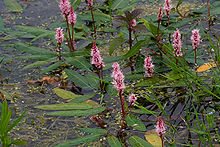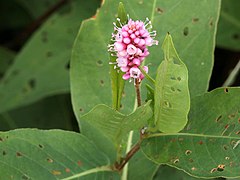Persicaria amphibia (original) (raw)
From Wikipedia, the free encyclopedia
Species of plant
| Persicaria amphibia | |
|---|---|
 |
|
 |
|
| Conservation status | |
 Secure (NatureServe)[1] Secure (NatureServe)[1] |
|
| Scientific classification |
|
| Kingdom: | Plantae |
| Clade: | Tracheophytes |
| Clade: | Angiosperms |
| Clade: | Eudicots |
| Order: | Caryophyllales |
| Family: | Polygonaceae |
| Genus: | Persicaria |
| Species: | P. amphibia |
| Binomial name | |
| Persicaria amphibia(L.) Gray | |
| Synonyms | |
| Synonymy Polygonum amphibium L. Chulusium amphibium (L.) Raf. Chulusium fluitans Raf. Chulusium natans Raf. Persicaria amurensis (Korsh.) Nieuwl. Persicaria coccinea (Muhl. ex Willd.) Greene Persicaria fluitans Montandon Persicaria hartwrightii (A. Gray) Greene Persicaria muhlenbergii (Meisn.) Small Polygonum amphibium L. Polygonum coccineum Muhl. ex Willd. Polygonum emersum (Michx.) Britton Polygonum hartwrightii A. Gray Polygonum muhlenbergii (Meisn.) S. Watson Polygonum natans Eaton Polygonum rigidulum E. Sheld. Polygonum salicifolium Schur 1866 not Brouss. ex Willd. 1809 |
Persicaria amphibia (syn. Polygonum amphibium) is a species of flowering plant in the knotweed family known by several common names, including longroot smartweed, water knotweed, water smartweed, and amphibious bistort. It is native to much of North America, Asia, Europe, and parts of Africa,[2] and it grows elsewhere as an introduced species and sometimes a noxious weed.[_citation needed_]
Distribution and habitat
[edit]
Persicaria amphibia is native to a large area across the northern hemisphere, including Europe, Asia, North America, and parts of Africa. It has been introduced elsewhere, such as South America and other parts of Africa.[3]
It grows in many types of wet habitat, such as ponds, streams, and marshes. It is a rhizomatous perennial herb which takes a variety of forms and is quite variable in morphology. It may be an aquatic plant, growing submerged or floating in water bodies, it may grow in muddy and wet areas which are periodically inundated, and it may grow in moist spots on land, such as in meadows.
Dry-land and fully aquatic plants are sometimes considered different named varieties of the species.[4]
Persicaria amphibia produces a thick stem from its rhizome. The stem may creep, float, or grow erect, rooting at stem nodes that come in contact with moist substrate. Stems are known to reach 3 meters (10 feet) long in aquatic individuals. The stems are ribbed and may be hairless to quite hairy in texture.[4]
Leaves are lance-shaped or take various other shapes and are borne on petioles. They may be over 30 centimeters (1 foot) in length. The inflorescence is a dense terminal cluster of many five-lobed pink flowers.[4]
Plants may have bisexual or unisexual flowers, with some plants bearing only male or only female flowers. The fruit is a shiny brown rounded achene around 3 mm (0.12 in) long.[4]
Three varieties are generally recognized, though some authorities consider P. a. var. emersa a distinct species, Persicaria coccinea.[5]
- P. a. var. emersa (longroot smartweed) – Plants palustrine, usually with emergent leafy stems; ocreae never with flared apices; aerial leaves petiolate with acuminate tips; inflorescence spikes terminal, usually 2 (unequal), > 4 cm long.[5]
- P. a. var. stipulacea – Plants aquatic, usually with floating stems and leaves; ocreae with flared apices (when stranded); aerial leaves (when present) nearly sessile with somewhat cordate bases and blunt apices; inflorescence spikes usually 1, greater than 4 cm (1.6 in) long.[5] In North America, P. a. var. stipulacea does not grow south of the Laurentide Ice Sheet except in the mountain west and Mexico.[6]
- P. a. var. amphibia – European[4]

P. a. var. emersa long spike
P. a. var. emersa short spike
P. a. var. stipulacea aquatic form
P. a. var. stipulacea terrestrial form
P. a. var. amphibia
Various parts of this plant were used by several Native American groups as medicinal remedies and sometimes as food.[7]
- ^ "Polygonum amphibium, Water Smartweed". explorer.natureserve.org. NatureServe. Retrieved 25 October 2020.
- ^ "Persicaria amphibia". Germplasm Resources Information Network. Agricultural Research Service, United States Department of Agriculture. Retrieved 21 December 2017.
- ^ Persicaria amphibia. The Jepson Manual, University of California, 2013.
- ^ a b c d e Persicaria amphibia. Flora of North America.
- ^ a b c Reveal, J. L.; Atha, D. E. (2012). "Persicaria (L.) Mill. Smartweed". In Cronquist; et al. (eds.). Intermountain Flora. Vol. 8. Bronx, NY: New York Botanical Garden Press. pp. 236–250.
- ^ "GSA 2018 – Kirk Bryan Field Trip – At the Edge of the Laurentide Ice Sheet: Stratigraphy and Chronology of Glacial Deposits in Central Indiana". Geological Society of America. 6 December 2018.
- ^ Polygonum amphibium. Native American Ethnobotany. University of Michigan, Dearborn.
